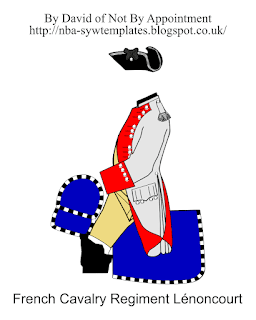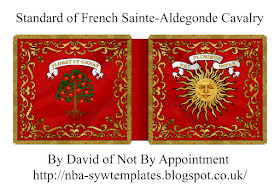First raised 1666. 2 squadrons strong in 1756 and ranked 18th.
Standard carried probably from at least 1688-1761
1689: Conquest of the Palatinate
1691: Italy
1692: Flanders and the battle of Steenkerque
1701: Army of Italy and combat of Chiari
1702: Battle of Luzzara; capture of Luzzara and Borgoforte
1703: Expedition to Trentin; combats of Santa Vittoria and San Benedetto
1704: Sieges of Verceil, Yvreé and Verrue
1705: Combat of Cassano
1706: Battle of Calcinato and siege of Turin
1707: Spain and the battle of Almanza; capture of Lerida
1708: Siege of Tortosa
1710: Guarding the frontier of Dauphiné
1713: Back to Spain and the siege of Barcelona
1727: Camp of Aimeries
1732: Camp of the Meuse
1734: On the Rhine; siege of Philipsbourg, the attack on the Lines of Ettlingen and the combat of Klausen. Quartered in Moulins at the peace.
1742: The frontier of Flanders
1743: To Bavaria then back to Alsace, in the vicinity of Landau
1744: The capture of Weissembourg, the taking of the Lines of Lauter, the combat of Augenheim and the siege of Fribourg
1745: The capture of Kronembourg then the siege of Ath
1746: The siege of Mons and battle of Roucoux
1747: Battle of Lawfeld and the capture of Bergen op Zoom
1748: Siege of Maastricht
1749: To Bourges
1751: To Neufbrisach
1752: To Montpellier, Castenaudary and Castres
1753: The camp of Plobsheim, then returned to Castres
1753: 10th September Took the name of Aquitaine
1754: Left Castres for Bergerac and Libourne
1756: To Besançon
1757: To Damvilliers and Stenai
In the Seven Years War served at the battle of Hastenbeck, the conquest of Hanover, and distinguished at the battle of Krefeld. Then at the battles of Lutzelberg, Corbach, Warburg, Clostercamps and Villingshausen
1761: Given to the Count of Artois and took the name Artois (which it kept to the Revolution). Incorporated companies of the regiment of Héricy and increased to 4 squadrons. Reorganised 30th April 1763.
1762: Manning the coast
1763: At the peace sent to Besançon
And this was the uniform in 1756:


















































